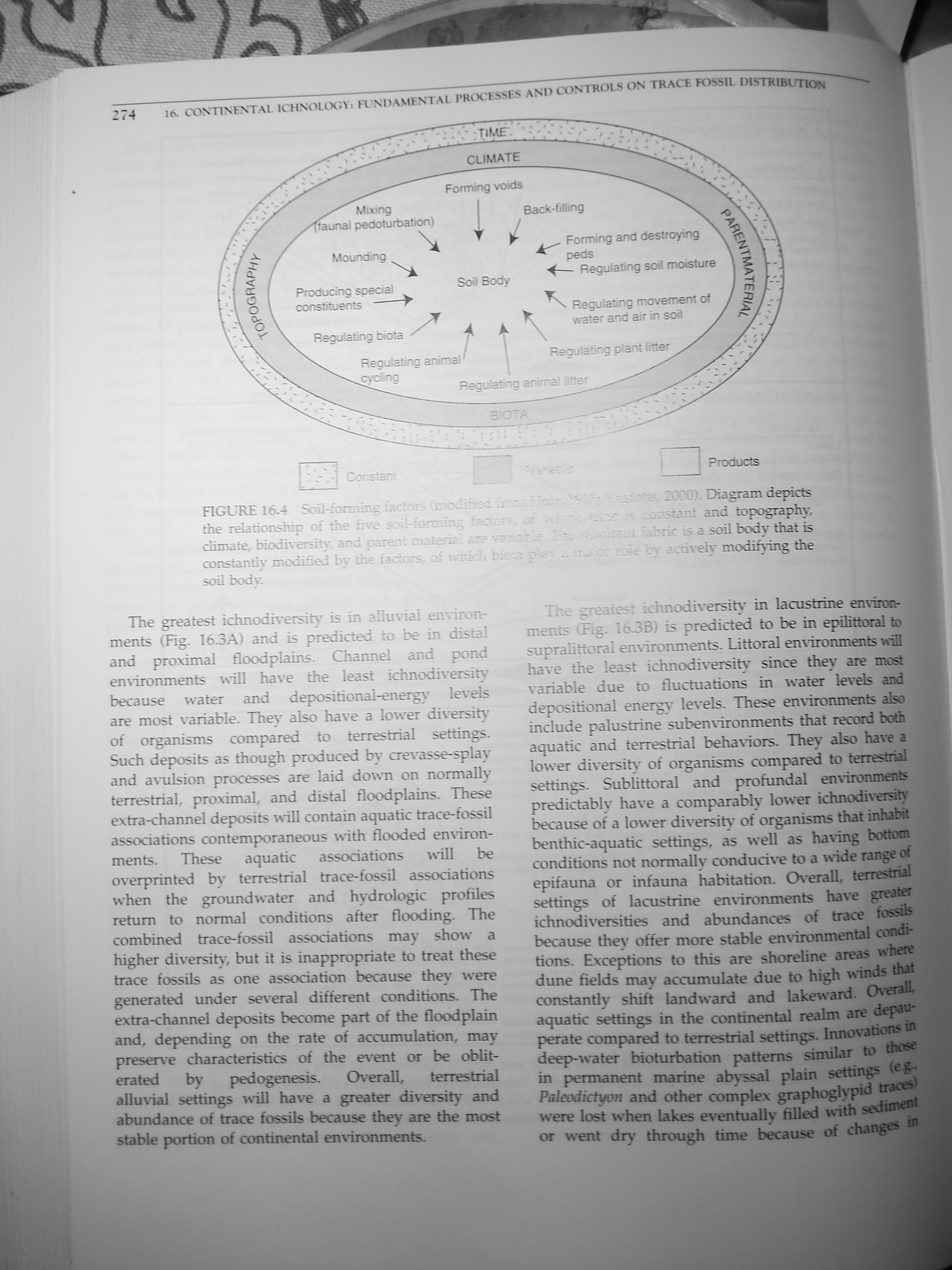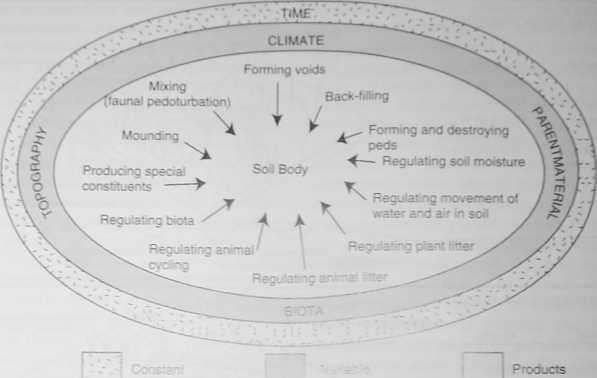dsc08786 (3)

274
16. CONTINENTAL ICHNOLOGY: FUNDAMENTA!. 1‘ROCESSES AND CONTROLS ON TRACĘ FOSSIL DISTRIBCTHON

FIGURĘ 16.4 Sofl-fonning\ ■ 2000) Diagram depicts
the rdationship o£ the five 5 c-il-ronrir: z * • and topography,
dimate, biodiversitv, and parer.: n^aien.' ■ -. - “ V.~ r. ~ .s a soilbody thatis
constantly modified by the taciors, of whkh biota ; -e - .. r-: h e :uveły modifying the soil body.
The greatest ichnodiversity is in aUuvial emiron-ments (Hg. 16.3A) and is predicted to be in distal and proximal floodplains. Channel and pond emiromnenis will have the least ichnodiversity because water and depositional-energy levels are most variable. They also have a lower diversity of organisms compared to terrestrial settings. Such deposits as though produced by crevasse-splay and avulsion processes are laid down on normally terrestrial, proximal, and distal floodplains. These extra-channel deposits will contain aquatic trace-fossil associations contemporaneous with flooded environ-ments. These aquatic associations will be overprinted by terrestrial trace-fossil associations when the groundwater and hydrologie profiles return to norma] conditions after flooding. The combined trace-fossil associations may show a higher diversity, but it is inappropriate to treat these tracę fossils as one assodation because they were generated under several different conditions. The extra-channel deposits become part of the floodplain and, depending on the ratę of accumulatkm, may preserve characteristics of the event or be oblit-erated by pedogenesis. OveraIl, terrestrial alluvial settings will have a greater diversity and abundance of tracę fossils because they are the most stable portion of Continental enyironments.
le greatest ichnodiversity in lacustrine environ-ments (Rg. 16.3B) is predicted to be in epilittoral to supralittoral environments. Littoral emironmertswiD have the least ichnodiversity sińce they are most yariable due to fluctuations in water levełs and depositional energy levels. These emironments also indude palustrine subemironments that recotd both aquatic and terrestrial behaviors. They also have a lower diversity of organisms compared to terrestrial settings. Sublittoral and profundal enviroiunents predictably have a comparably lower ichnodiversity because of a lower diversity of organisms that inhabii benthic-aquatic settings, as well as having bottom conditions not normally conduave to a \vide rangę of epifauna or infauna habitation. OveraH, terrestrial settings of lacustrine ensironments have greater ichnodiversities and abundances of tracę fossils because they offer morę stable emironmental conditions- Exceptions to this are shordine areas where dune fields may accumulate due to high ^inds that constantly shift landward and lakeward. OvenD, aquatic settings in the Continental realm are depau-perate compared to terrestrial settings. lnnovations in deep-water bioturbation pattems similar to those in permanent marinę abyssal plain settings (eg . Paleodictyon and other oomplex graphoglypid tracę) were lost when lakes eventually filkd with sediment or went dry through time because of changę in
Wyszukiwarka
Podobne podstrony:
dsc08789 (3) 276 16. CONTINENTAL ICHNOLOGYi FUNDAMBNTAL PROCESSES AND CONTROLS ON TRACĘ FOSSIL DISTR
dsc08794 (2) 278 16. CONTINENTAI. ICHNOLOGYi FUNDAMENTAL PROCESSES AND CONTROLS ON TRACĘ FOSSIL DIST
dsc08776 (3) C H A P T E RContinental Ichnology: Fundamental Processes and Controls on Tracę Fossil
dsc08779 (2) 70 16. CONTINENTAL ICHNOLOGY: FUNDAMENTAL PROCESSES AND CONTROLS ON T
dsc08787 (3) 274 16. CONTINENTAL 1CHNOLOGY: FUNDAMENTAL PROCESSES AND CONTROLS ON
dsc08800 (3) 284 16. CONTINENTAL ICHNOLOGY: FUNDAMENTAL PROCESSES AND CONTROLS ON
dsc08798 (3) 282 16. CONTINENTAL 1CIINOLOGY: PUNDAMENTAL PROCESSES AND CONTROLS ON TRACĘ FOSSIL DIST
dsc08784 (3) 272 16. CONTINliNTAI. K IINOI.OOYi RJNDAMIINTAI, PH0OUŚBHH ANI) ( ON
img019 (16) They walk to her fire, and stand on the feet. And still she sits, and still she sews, an
dsc08778 (2) FIGURĘ 16.1 Continental realm: biophysicochemical factors. Diagram depicts the and temp
14 (12) as 3 I a-o l»e«9H 2* I przodu i tylu Ooknnczomo do modoZu 16 Pizcd. “a i kwadratu? 1-6 (»1 k
001 (6) r> ro ro ro ro ro ro ro ro ro ro ro ro ro ro ro ro ro ro fo ro ro ro ro ro ro —1 _A _A _A
274 (16) 7 INSTALACJA ELEKTRYCZNA Schemat 18. ŚWIATŁA PRZECIWMGŁOWE TYLNE. OGRZEWANE DYSZE SPRYSKIWA
ogoniok3 &.!. IlpHMyc COCTOHT H3 UHAHHApH4eCKOfO KOWVXa «16» C 4-MH nOABHJKHUMH CTOfiKaMH «1>
Zadanie 0.16 Dane są punkty: A{, 3), B(4,7), C(2,8), D(—1,4). Sprawdzić, że są one wierzchołkami
więcej podobnych podstron